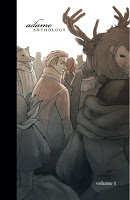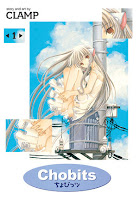My News and Reviews
Quite unintentionally, last week’s reviews were full of immortals. To start with, I posted my latest in-depth Blade of the Immortal manga review—Blade of the Immortal, Volume11: Beasts. It’s a pretty brutal volume, but it also includes some very important plot and character developments. I also posted a review of Fumi Nakamura’s debut novel Enma the Immortal. I enjoyed the book immensely and easily count it as one of my favorites of the year. Historical fantasy, immortality, demons, tattoos, Shinsengumi, and even shadows of Jack the Ripper—Enma the Immortal is some seriously great stuff.
Well, I honestly didn’t expect it to happen, but Digital Manga’s most recent Kickstarter project managed to exceed it’s final stretch goal. As a result, Digital Manga will be publishing three of Osamu Tezuka’s works in English: Unico, Atomcat, and Triton of the Sea. Granted, before the project closed Digital Manga announced that even if the goal was not met Triton would still be published. Digital Manga’s use of Kickstarter to fund publishing has been somewhat controversial in the manga blogging community. The most recent Manga Out Loud podcast episode takes another look at Digital Manga and Kickstarter (among other things). I haven’t had the chance to listen to it yet, but the featured guests include both critics and supporters. And speaking of Kickstarter, another project deserving of some attention is an alternative comics tribute anthology to the alternative and influential manga magazine Garo.
Today marks the beginning of CLAMP Manga Moveable Feast hosted by Manga Bookshelf! Melinda Beasi has written a phenomenal introductory post, so do check it out. In honor of the feast, my quick takes for this week all feature works by CLAMP. I’ll also be posting an in-depth manga review of the Clover omnibus later in the week.
Quick Takes
 Cardcaptor Sakura, Omnibus 3 (equivalent to Volumes 7-9) by CLAMP. There is something about Cardcaptor Sakura that I find utterly delightful and charming. Despite it’s adorable surface, CLAMP somehow avoids making the series too sickeningly sweet. The artwork and characters are cute but are balanced by a story with ominous overtones. I was wondering where CLAMP would be taking the series since by the end of the second omnibus Sakura had found and gained mastery of all of the missing Clow cards. The story goes off in a slightly different direction, but the second half of the series continues to challenge Sakura and her skills while introducing new characters. I’m looking forward to the final omnibus.
Cardcaptor Sakura, Omnibus 3 (equivalent to Volumes 7-9) by CLAMP. There is something about Cardcaptor Sakura that I find utterly delightful and charming. Despite it’s adorable surface, CLAMP somehow avoids making the series too sickeningly sweet. The artwork and characters are cute but are balanced by a story with ominous overtones. I was wondering where CLAMP would be taking the series since by the end of the second omnibus Sakura had found and gained mastery of all of the missing Clow cards. The story goes off in a slightly different direction, but the second half of the series continues to challenge Sakura and her skills while introducing new characters. I’m looking forward to the final omnibus.
 Gate 7, Volumes 1-2 by CLAMP. Gate 7 is such a frustrating series for me. The artwork is simply gorgeous. However, the story (once CLAMP finally remembers to get around to it) isn’t able to stand up to it. The male lead, Chikahito, doesn’t seem to serve any purpose at this point in the manga despite the cryptic comments made by the other characters which would seem to imply otherwise. Underneath the narrative mess there are some cool elements that CLAMP is playing around with. I’m particularly interested in the reincarnations of historical figures from the Sengoku era (who, thanks to CLAMP, all have very attractive character designs) and the roles played by the oni. But, as badly as I want to like Gate 7, it’s just not coming together yet.
Gate 7, Volumes 1-2 by CLAMP. Gate 7 is such a frustrating series for me. The artwork is simply gorgeous. However, the story (once CLAMP finally remembers to get around to it) isn’t able to stand up to it. The male lead, Chikahito, doesn’t seem to serve any purpose at this point in the manga despite the cryptic comments made by the other characters which would seem to imply otherwise. Underneath the narrative mess there are some cool elements that CLAMP is playing around with. I’m particularly interested in the reincarnations of historical figures from the Sengoku era (who, thanks to CLAMP, all have very attractive character designs) and the roles played by the oni. But, as badly as I want to like Gate 7, it’s just not coming together yet.
 X, Omnibus 1 (equivalent to Volumes 1-3) by CLAMP. I wasn’t expecting to enjoy X as much as I did; a few years ago, I gave the first volume a try and wasn’t particularly impressed by it. I decided to give the series another chance when the omnibus editions began to be released. Although I had been warned, I was still surprised by how bloody and graphic the manga gets. X has its quirks: the dialogue is completely unrealistic; a lot of the esoteric imagery seems to be a stylistic choice rather than being used for actual symbolism; and although appropriate for an end-of-the-world scenario, the unfolding drama is very much over the top. But even considering all of this, I found the manga strangely addictive. I’ll definitely be reading more of X.
X, Omnibus 1 (equivalent to Volumes 1-3) by CLAMP. I wasn’t expecting to enjoy X as much as I did; a few years ago, I gave the first volume a try and wasn’t particularly impressed by it. I decided to give the series another chance when the omnibus editions began to be released. Although I had been warned, I was still surprised by how bloody and graphic the manga gets. X has its quirks: the dialogue is completely unrealistic; a lot of the esoteric imagery seems to be a stylistic choice rather than being used for actual symbolism; and although appropriate for an end-of-the-world scenario, the unfolding drama is very much over the top. But even considering all of this, I found the manga strangely addictive. I’ll definitely be reading more of X.
 Chobits directed by Morio Asaka. My introduction to CLAMP’s work was through the Chobits manga series. If I hadn’t already read the manga, I might have enjoyed the anime adaptation more. As it was, I found the anime a chore to get through. The anime switched the story’s focus too much for my liking. Or maybe there was just too much filler and not enough attention given to the actual plot. The series now mostly seems to be about Chi being cute and doing cute things, which for me are the least interesting aspects of Chobits. I much prefer the more serious explorations of human-persocom relations and what it means to love someone. These elements still exist in the anime, but they aren’t emphasized as much as the romantic comedy is.
Chobits directed by Morio Asaka. My introduction to CLAMP’s work was through the Chobits manga series. If I hadn’t already read the manga, I might have enjoyed the anime adaptation more. As it was, I found the anime a chore to get through. The anime switched the story’s focus too much for my liking. Or maybe there was just too much filler and not enough attention given to the actual plot. The series now mostly seems to be about Chi being cute and doing cute things, which for me are the least interesting aspects of Chobits. I much prefer the more serious explorations of human-persocom relations and what it means to love someone. These elements still exist in the anime, but they aren’t emphasized as much as the romantic comedy is.






